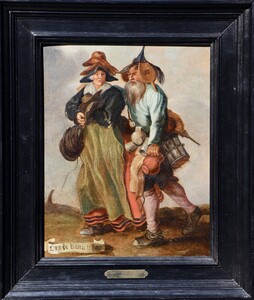Adriaen Pietersz. van de Venne
“Armoe’ soeckt list” (“Poverty leads to cunning”)
Oil on panel, en brunaille : 37,4 X 30,6 cm
Signed lower right “AD : v :Ven”
Sold at Sotheby’s New York, 22/04/15
For 156.250 $ = 145.750 €
This is a comparative item

Painting for Sale

Venne, Adriaen Pietersz. van de
"It is all about the profit"
In short
Adriaen van de Venne was a sharp observer, a painter, a book illustrator, and a poet with a good sense of humour who specialised in these humoristic genre scenes, after he had moved in 1625 to The Hague. He described his art as “Sinne-cunst”, that is “the art of wit”.
The text in the banderole can be translated as “it is all about the profit”: a funny couple of peddlers carry too many goods on their way to the market.
About Adriaen Pietersz. van de Venne
Dutch painter
Delft 1589 – 1662 The Hague
Genre and landscape painter and draughtsman, also a poet.
Van de Venne’s parents had fled religious persecution to Holland, as so many other Flemish Protestants. His father, Pieter, was a fruit seller from Lier, who settled with his family in Delft.
Pupil of two further unknown painters: Simon de Valck (who is also known as a goldsmith) and the grisaille painter Jeronymus van Diest I.
Van de Venne’s career was divided over 2 towns: Middelburg and The Hague.
Van de Venne lived in Middelburg from 1614 (the year that he got married) until 1625. Here he specialised in anecdotic genre-paintings and landscapes with lots of figures inspired by the Flemish painter Jan Brueghel I; he also painted monochrome portraits of the “Stadtholders”. Together with his elder brother Jan, a well-known publisher, he embarked onto other activities, as book illustrator (for the famous poet Jacob Cats, at least until 1656), print designer (strong political propaganda) and poet. Adriaen left Middelburg after Jan died in the spring of 1625.
From 1625 until his death in 1662 van de Venne lived in The Hague, the political hart of the Dutch Republic. Now he stood even closer to the house of Orange Nassau (‘stadtholder’ Maurits died in 1625 and was succeeded by Frederic Henry) and to the Winter King and Queen (Frederic V had been the leader of the unsuccessful Protestant upraise in the Holy Roman Empire, he was married with Elizabeth Stuart).
Here in The Hague van de Venne mainly made monochrome grisaille-paintings (the earliest ones date from 1621). These were very often satirical, concentrating on human folly, bearing a moralistic painted title.
The choice for a monochrome palette was typical of the fashion in Dutch painting in the second half of the 1620s and in the 1630s. One finds similar single muted tonalities back in maritime painting (Jan Porcellis), tonal landscape painting (Jan van Goyen) and in still life painting (monochrome breakfasts by Haarlem painters, such as Pieter Claesz and Willem Claesz. Heda).
During this second stage of his career Adriaen van de Venne continued his other activities. He never practised himself engraving, but employed numerous reproductive printmakers. Together with Joost Ockers he had a publishing and printing office. The house that Adriaen bought in 1630 also held a shop where he (and later his son Pieter) sold his books and engravings.
Both Adriaen’s sons were also painters:
- Pieter (1624-1657) was a still life specialist;
- No paintings are known by Huybrecht (1635-1676 or later).
-
Of Leonaert Bramer (1596 – 1674) and of Sybrand van Beest (circa 1610 – 1674) it is thought that they possibly also had been pupils of Adriaen van de Venne.
About van de Venne’s combination of poetry, humour and painting
Van de Venne was a very versatile artist, gifted with a narrative clarity; he was witty, skilled and original, responding vividly to contemporary life and politics. He was a sharp observer of human behaviour.
He was an exceptional painter because he combined poetry, humour and painting. He considered this/his combination an art form that would surpass all others because "the mind plays so prodigiously within it that nothing else is so blessed with meaning". He called this art form in 1623 “Sinne-cunst”, that is “the art of wit”.
Both bearers of wisdom, poetry and painting, would reinforce each other, leading to a better didactic and moralizing message. Humour helped to get this message across: one smiles not only at his clever word play in the banderole, but also at his visual jokes about farmers, beggars and marginal figures.
Van de Venne applied his artistic credo of the “Sinne-cunst” in grisaille (painted solely in grey tonalities), brunaille (solely in brown tonalities) and also in polychrome paintings from his second artistic period, in The Hague (1625 – 1662) with the introduction of banderoles with a short text. Often there are different levels of interpretation of the combination of word and image, appealing to the viewer’s intellect.
Contemporary emblem books show a comparable juxtaposition of image and text.
About our painting
Van de Venne has regularly criticised the shortcomings of modern man, the avarice and greediness of contemporary society in a rather vicious, grim way full of disturbing realism. An inscription painted in a banderole provides a humorous or ironic commentary on the scene.
Van de Venne usually portrayed grotesquely painted members of the lowest, marginalised social levels: they were morally and therefore sometimes physically deformed. This exaggeration would underline their lack of civic and civilised behaviour. Here we see a ridiculous couple of peddlers: she is carrying too many hats, her husband carries jugs and blow pipes.
Why should you buy this painting?
Because it is a comic, but grim complaint against the pursuit of profit, of money, in his contemporary society. Not much has changed over the past four centuries.
Comparative paintings
Click photos for more details












